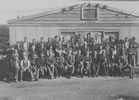Kaimai Range
Mountain range separating western Bay of Plenty from Waikato. It stretches from the highest point, Mt Te Aroha (952 m) in the north, to the Mamaku Range west of Rotorua.
The range is divided by valleys and still mostly forest-covered. It is crossed by tracks but by only one road, State Highway 29. The 8.9-km Kaimai Tunnel bisects the range, connecting Waikato with the Bay of Plenty and Port of Tauranga.
The lower reaches provided refuge for Māori forced from their settlements during times of war, the last being the New Zealand wars and consequent land confiscations of the 1860s. Milling of kauri trees in the range took place in the late 19th and early 20th centuries. Since 1975 part of the range has been incorporated in the Kaimai Mamaku Forest Park, which marks the southern limit of kauri and the northern limit of red and silver beech. The fauna includes rare species such as North Island brown kiwi, kōkako, kākā, Hochstetter's frog, striped skinks, and long- and short-tailed bats.
On 3 July 1963 a National Airways Corporation DC3 crashed on the range as it was descending towards Tauranga Airport, killing all 23 people on board. This remains the worst air disaster on New Zealand soil.
Tauranga Harbour (Tauranga Moana)
Tidal stretch of water between Matakana Island and the North Island mainland. It joins the Pacific Ocean through the northern Katikati and the southern Tauranga entrances.
The harbour encompasses some 200 sq km and has a tidal range of up to 1.98 m. Approximately 290 million tonnes of water flow through the entrances at each tidal change. The harbour was formed when sea levels rose at the end of the last ice age. The waters are shallow, with large areas of mangroves exposed at low tide. Waders, royal spoonbills and kōtuku (white herons) feed here.
A sight for sore eyes
This is a description of Tauranga Harbour from 1938:
‘As the weary traveller drives up from the barren recesses of the Waihī Gorge on to the ridge by the Athenree homestead, he comes suddenly upon a scene of surpassing beauty. Directly in front of him the blue waters of Tauranga Harbour sparkle in the sunshine. On the left lie the twin domes of the Katikati Heads, and the open sea stretching to the wooded peaks of Mayor Island and beyond’. 1
Wairoa River
Major river of the Bay of Plenty. With its tributaries it drains the country north of Tauranga and enters the Tauranga Harbour near Te Puna. State Highway 29 from Waikato follows part of its course, and Ruahīhī power station is on the river adjacent to the road.
The Omanawa and Mangapapa rivers are important tributaries. There were hydroelectric power stations on the Omanawa River in the 1920s, and the Lloyd Mandeno and Lower Mangapapa power stations are located on the Mangapapa River.
Matakana Island
Large island, mostly sandy, stretching between the two Tauranga Harbour entrances. In 1924 Māori of Ngāi Te Rangi were growing crops and running dairy herds. Pines were planted during the 1920s and 1930s, and many stands have been harvested and replanted. The peninsula facing the mainland, and neighbouring Rangiwaea Island, are still farmed, mostly by Māori, although the population is dwindling: in 2006 it was 222.
Ōmokoroa
Farming locality on the southern shoreline of Tauranga Harbour, 18 km north-west of Tauranga. Ōmokoroa Beach, 10 km north, is a boating resort and retirement area. A ferry service to Matakana Island runs from the wharf there.
The 2013 population was 2,547. It has been growing substantially since the 1960s. 34.3% are aged 65 and over (the regional average is 18.5%), and 93.3% have European ethnicity (compared with 78.4% for the region overall).

